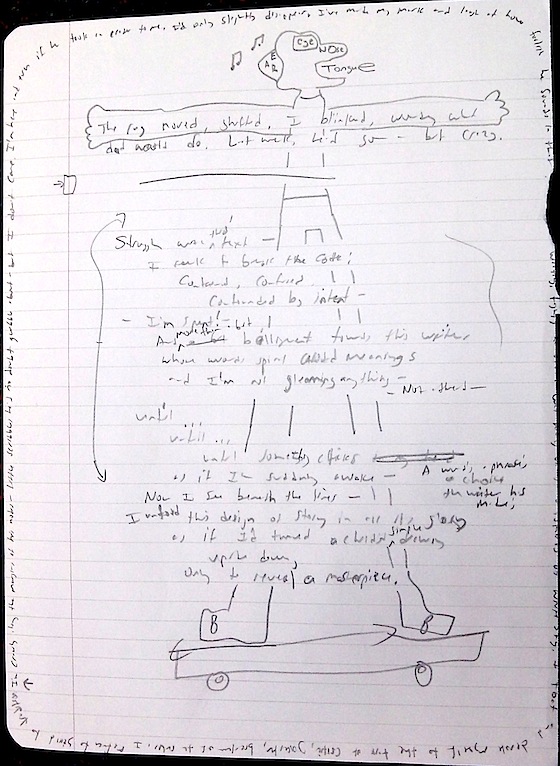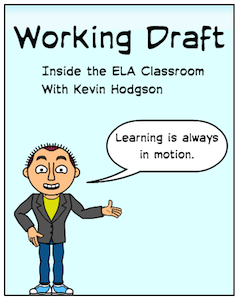Writing With Them
A MiddleWeb Blog
We write a lot in my sixth grade classroom.
And by “we,” I don’t mean just my students. I mean, me, too. I write with them. I’ll pull up an empty chair, or move to an unoccupied desk, or sometimes sit on the floor, with one of my many notebooks in hand, and I will write right alongside them. I can tell during the first part of the year how unusual this is for them, to have a teacher in the midst. They gawk at me, a bit, curious about what I am up to. I just keep on writing, and soon, it just becomes part of the routine of the classroom.
When they share out what they’ve been working on with the class, which they do on a regular basis, I sometimes share what I am working on, too. Sometimes I don’t. I give myself the same freedom as I give them.
~ Listen to a podcast of this post ~
The other day, though, I shared out the page below from my writing notebook with my students. We had been doing some extended freewriting, giving them an opportunity to compose whatever they wanted, and just like them, I had started with a blank page and only a few scattered ideas.
There were audible gasps, and appreciative laughter, as they looked at the mess of my notebook page. Heck, it is a mess. I have doodles, pieces of a poem, the start of a story, and a weird piece of writing that started in the bottom left corner of the page and ended up stretching around the border like some painted trim work in the living room.
 I’m apt to scribble out words and phrases all the time, particularly with poetry or songwriting when I am aiming for rhythm. Don’t get me started on my handwriting, either, which was ruined (or so I will stipulate in any court of law) by ten years as a newspaper reporter on the run with a small notebook in which I had to scramble to capture quotes during interviews on the fly. I have a shorthand system all of my own and my handwriting never recovered from my newspaper days (but I can type like a madman).
I’m apt to scribble out words and phrases all the time, particularly with poetry or songwriting when I am aiming for rhythm. Don’t get me started on my handwriting, either, which was ruined (or so I will stipulate in any court of law) by ten years as a newspaper reporter on the run with a small notebook in which I had to scramble to capture quotes during interviews on the fly. I have a shorthand system all of my own and my handwriting never recovered from my newspaper days (but I can type like a madman).
The writer behind the curtain
I think it’s important that my students see the chaos of my writing. All too often, my sixth graders think of the writers they most enjoy — Rick Riordan, Suzanne Collins, etc. — and imagine these authors sitting down and pumping out a complete book in a sitting or two. They understand a bit about the publishing process — about how editors work with writers — but they don’t comprehend the number of dead ends, lost threads and abandoned texts that no doubt litter many writers’ notebook pages.
They know I write, and sometimes I do get things published in our local newspaper and in online spaces. I am trying to teach these young learners how to be writers, and how sometimes, writing is for that single moment alone (I had a blast writing that story around the edge of my notebook because I was making fun of myself writing the poem in the center of the page but it won’t ever leave that paper) and sometimes, a small piece of an idea will spark inspiration for something longer and more polished.
When we write with our students, we show them the real world. When we share our writing, and the process of that writing, we show them our real selves. Writing can become a connecting thread in the classroom. Go on. Write with them.
By the way, if you are wondering what happened to the poem I was writing in the middle of the page, this is how it turned out. I had been thinking about Close Reading strategies and that inspired this piece of writing.
When the Key Clicks
Struggling
with this text –
I seek to break the code.
Contained, confused, confounded
by intent: I’m spent!
And more than a bit belligerent towards this writer
whose words spiral around meaning like
a swirling subterfuge of ideas just out of reach
when I’m not gleaning anything …
Until …
Until ..
Until somehow the key clicks.
Perhaps it was a word you said
or a question you asked
or another angle on which to lay my head upon this table.
For suddenly, I’m awake for the very first time, seeing
beneath the lines
between the words.
I unfold this story in all of its glory
as if I’d just turned a child’s simple drawing
upside down
inside out
only to discover a masterpiece hidden beneath
waiting to be explored.



































Kevin, thank you for the early morning laugh as your discriptive language gave me an image of a classroom alive and unafraid to laugh out softly without a care. We need more teachers like you and I am smiling to know that you are “out there”.
I am gratified to know that there is at least one other classroom teacher who writes – and shares that writing – with students. I have found this sharing to be the most effective and least threatening way to provide instruction in the peer-editing skills that I want them to hone. Not to mention that it is fun!
Thanks, William. I know I learned about how to shift from being a teacher of writing to being a teacher who writes with the National Writing Project. Plus, why should kids get all the fun? But, more seriously, I believe we teachers need to model what we expect our students to be doing.
Kevin
Thank you, Linda, for taking the time to write here, too. I’m glad the post resonated and affirmed what you already know to be true about young writers and their teachers.
Kevin